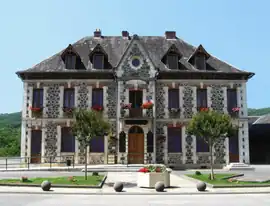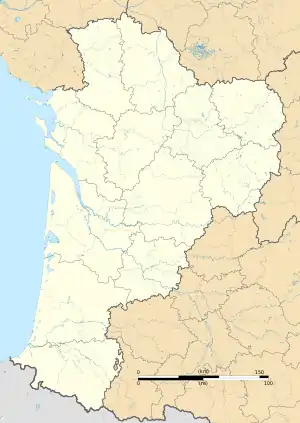Altillac | |
|---|---|
 The Town Hall of Altillac | |
.svg.png.webp) Coat of arms | |
Location of Altillac | |
 Altillac  Altillac | |
| Coordinates: 44°58′40″N 1°50′48″E / 44.9778°N 1.8467°E | |
| Country | France |
| Region | Nouvelle-Aquitaine |
| Department | Corrèze |
| Arrondissement | Brive-la-Gaillarde |
| Canton | Midi Corrézien |
| Intercommunality | Midi Corrézien |
| Government | |
| • Mayor (2020–2026) | Denis Pinsac[1] |
| Area 1 | 25.23 km2 (9.74 sq mi) |
| Population | 826 |
| • Density | 33/km2 (85/sq mi) |
| Time zone | UTC+01:00 (CET) |
| • Summer (DST) | UTC+02:00 (CEST) |
| INSEE/Postal code | 19007 /19120 |
| Elevation | 136–502 m (446–1,647 ft) (avg. 146 m or 479 ft) |
| 1 French Land Register data, which excludes lakes, ponds, glaciers > 1 km2 (0.386 sq mi or 247 acres) and river estuaries. | |
Altillac (French pronunciation: [altijak]; Occitan: Altilhac) is a commune in the Corrèze department in the Nouvelle-Aquitaine region of central France.
The inhabitants of the commune are known as Altillacois or Altillacoises.[3]
Geography

Altillac is a large commune located in the central massif of the Dordogne in eastern Nouvelle-Aquitaine (previously the smaller Limousin region until 2016), almost on the border with Occitania (previously Midi-Pyrénées). It was formerly called Xaintrie.
It is located some 30 km south-east of Brive-la-Gaillarde, 130 km south-west of Clermont-Ferrand, and about 180 km east of Bordeaux. Access to the commune is on road D940 which goes to the village just 1 km east of Beaulieu-sur-Dordogne then continues south through the commune to Biars-sur-Cère. The D116E branches south-east from this road to join the D14 east of Gagnac-sur-Cère. There is also the D116 coming from Brivezac in the north and the D41 highway to La Chapelle-Saint-Géraud in the north-east.[4]
The Dordogne river forms the western boundary of the commune with some streams from the commune flowing into it including the Ruisseau du Suquet. The eastern border of the commune is formed by the Ruisseau d'Orges which flows south into the Ceres river. The northern border is formed by the Ruisseau de Chauvac which flows west into the Dordogne. The Ruisseau de Laumond on the eastern side also flows east into the Orges as does the Ruisseau de Malaval in the south.[4]
There are quite a number of villages and hamlets in the commune. These are:
- Andole
- Courbignac
- Esclaux
- Fontmerle
- Freyssignes
- Gramond
- Guilles
- L'Aumond
- L'Aussac
- La Borderie
- La Bourelle
- La Majorie
- La Palide
- La Poujade
- La Poulvélarie
- La Veyssière
- Le Rodal
- Le Sagrier
- Le Treil
- Les Escures
- Paliole
- Siran
History
Altillac was the seat of a Viguerie under the Carolingian dynasty.[5]
On 28 May 1942, the regional prefect of Limoges requisitioned land from the Chateau of Doux to create an internment centre for Jewish families.[6][7]
Heraldry
.svg.png.webp) Arms of Altillac |
The official status of the blazon remains to be determined.
Blazon:
|
Administration
List of Successive Mayors of Altillac:
| From | To | Name |
|---|---|---|
| 1808 | 1834 | Antoine Dauvis Bichiran |
| 1834 | 1837 | Jean Frédéric Bichiran |
| 1837 | 1878 | Jean Joseph Fontanille |
| 1878 | 1883 | Jean Baptiste Victor Borie |
| 1883 | 1884 | Joseph Lebrun |
| 1884 | 1885 | Jules d'Humières |
| 1885 | 1888 | Jules Argueyrolles |
| 1888 | 1904 | Philippe Dounier |
| 1904 | 1908 | Louis Lamond |
| 1908 | 1919 | Jean Versejoux |
| 1919 | 1934 | Ernest Faugère |
| 1934 | 1944 | Georges Mas |
| 1944 | 1945 | Romain Conche |
| 1945 | 1958 | Georges Mas |
| 1958 | 1977 | Romain Conche |
| 1977 | 1983 | Robert Audrerie |
| 1983 | 1995 | Pierre Poulvélarie |
| 1995 | 2001 | Jean-Claude Vergne |
| 2001 | 2020 | Robert Vialard |
| 2020 | 2026 | Denis Pinsac |
Population
| Year | Pop. | ±% p.a. |
|---|---|---|
| 1968 | 762 | — |
| 1975 | 720 | −0.81% |
| 1982 | 791 | +1.35% |
| 1990 | 824 | +0.51% |
| 1999 | 801 | −0.31% |
| 2007 | 844 | +0.66% |
| 2012 | 868 | +0.56% |
| 2017 | 861 | −0.16% |
| Source: INSEE[8] | ||
Culture and heritage
Civil heritage
- The Chateau du Doux was built in 1904-1906 from plans by Jean-Louis Pascal. Influenced by the style used in Deauville, it is built in the style of Xaintrie, the nearest town, to serve as a luxury hotel. It is built above a valley and offers views of the surrounding landscape. Different styles are used for the window frames: simple windows, large curved bayss with stone latticework, cross windows, skylights, and capucine passantes. It used local materials to allow it to have a regional air: stones of various colours and a slate roof. Inside, the woodwork is Art Nouveau.[7]
- On the other side of the valley is the Doux domain where large farm buildings have been built: huge barns/stables on two levels with many barns built in imitation of small farms, which form a semblance of a hamlet, a henhouse, and a bread oven. All buildings - the hotel and the farm buildings - are certified as heritage of the 20th century.[7]
- The Dolmen de la Borderie - a Neolithic Dolmen in good condition.[9]
Religious heritage
- The Church of Saint-Etienne (14th century)
 is registered as an historical monument.[5] It was built in 1528 except for the bell tower which dates back to the 14th century. The Church contains several items that are registered as historical objects:
is registered as an historical monument.[5] It was built in 1528 except for the bell tower which dates back to the 14th century. The Church contains several items that are registered as historical objects:
- A set of Baptismal fonts
 [10]
[10] - Covers for the Baptismal fonts (1700)
 [11]
[11] - Bowls for the Baptismal fonts (12th century)
 [12]
[12] - The panelling in the Choir (1676)
 [13]
[13] - 6 Bas-reliefs (1676)
 [14]
[14] - The panelling on the walls (1676)
 [15]
[15]
- A set of Baptismal fonts
Personalities
Notable personalities linked to the commune include:
- Jean-Antoine Marbot, born 7 December 1754 in Altillac – 19 April 1800: French divisional general and politician. Father of generals Adolphe and Marcellin Marbot.
- Adolphe Marbot, born 22 March 1781 in Altillac – 2 June 1844: French maréchal de camp (brigadier general).
- Marcellin Marbot, born 18 August 1782 in Altillac – 16 November 1854: French lieutenant-général (divisional general), author of the famous Memoirs of General Marbot.
- Marcel Conche, born 27 March 1922 in Altillac – 27 February 2022: French philosopher and professor emeritus of philosophy at the Sorbonne.
See also
References
- ↑ "Répertoire national des élus: les maires" (in French). data.gouv.fr, Plateforme ouverte des données publiques françaises. 13 September 2022.
- ↑ "Populations légales 2021". The National Institute of Statistics and Economic Studies. 28 December 2023.
- ↑ Inhabitants of Corrèze. (in French)
- 1 2 Google Maps
- 1 2 Base Mérimée: PA00099650 Church of Saint-Etienne, Ministère français de la Culture. (in French)
- ↑ "Château du Doux". Archived from the original on 15 July 2015. Retrieved 7 June 2013.
- 1 2 3 Colette Aymard (Director of Publication), Architecture and Heritage of the 20th century in Corrèze, Direction régionale des affaires culturelles du Limousin, 2010, p. 1-2. (in French)
- ↑ Population en historique depuis 1968, INSEE.
- ↑ Megaliths.
- ↑ Base Palissy: PM19001279 Set of Baptismal fonts, Ministère français de la Culture. (in French)
- ↑ Base Palissy: PM19000828 Covers for the Baptismal fonts, Ministère français de la Culture. (in French)
- ↑ Base Palissy: PM19000498 Bowls for the Baptismal fonts, Ministère français de la Culture. (in French)
- ↑ Base Palissy: PM19000006 Panelling in the choir, Ministère français de la Culture. (in French)
- ↑ Base Palissy: PM19000692 6 Bas-reliefs, Ministère français de la Culture. (in French)
- ↑ Base Palissy: PM19000691 Panelling on the walls, Ministère français de la Culture. (in French)
External links
- Altillac official website (in French)
- Altillac on the old National Geographic Institute website
- Altillac on Géoportail, National Geographic Institute (IGN) website (in French)
- Altillac on the 1750 Cassini Map